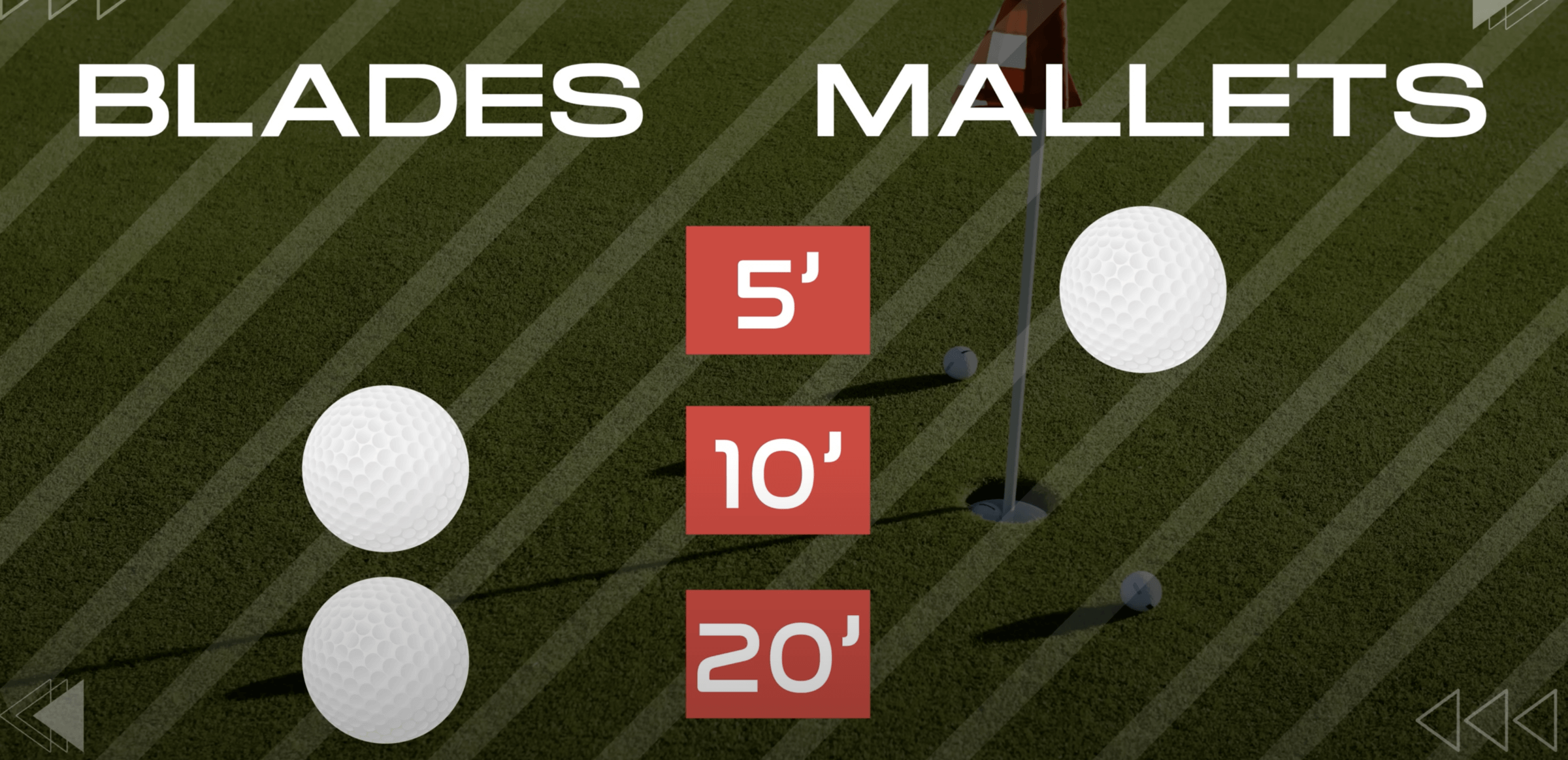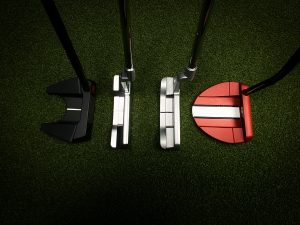With technology constantly changing, two simple constructions stay constant: blade and mallet putters. Over the years, we’ve seen some astonishing designs in both categories. There are classic, well-known ones such as Odyssey 2-Ball, PING Anser, Scotty Cameron Newport … the list goes on and on. But there are some head scratchers, too: PING’s Doc 17, Odyssey’s 2-Ball Blade, Axis1 and TaylorMade’s Truss.
Let’s face it: Looks and feel don’t always equal performance. What we really want to know is, is there a significant statistical performance difference between blades and mallets? If so, is the differential minor or major?
Key Takeaways
- Putters are crucial to your golf game, representing 40 percent of your scorecard.
- Technology and how it works with your stroke, not looks, are the key factors in putter performance.
- Both blade and mallet putters have their advantages so it’s essential to find the one that best suits your game.
Myth Busting
In our 10 years of testing putters at our Golf Lab, we have found zero correlation between visual cues and how a putter performs. In other words, looks do not matter. What does matter is how a putter works with your stroke and the technology in the putter that can help lower your score.
Blade Versus Mallet
In our testing, we considered how putters perform differently at various distances. We focused on three key distances: five, 10 and 20 feet. By breaking it down this way, we evaluated which style of putter works better for each distance.
Five-foot putts
We hit 23,000 putts using mallets and blades to determine which style is better from five feet. Mallets won. If you struggle with five-footers, a mallet-style putter might be a better fit for you.
10-foot putts
Moving on to 10-foot putts, we once again calculated 23,000 putts for both styles. From this distance, blades were the winners. This is arguably the most crucial distance as it can make a significant difference in your scorecard.
20-foot putts
Lastly, we examined the 20-foot putts and blades were the clear winner again. From long-range, blade-style putters proved to be more effective.
Conclusion: Blades are the best overall putter style when considering all distances.

Get Fitted
We also found a shocking statistic: 80 percent of you aren’t properly fitted for your stroke type. This highlights the importance of getting fitted for your putter as it can definitively help you lower your score.
When you get fitted for a putter, keep these tips in mind:
- Putt from five, 10 and 20 feet
- Hit an equal number of putts from each distance
- Compare the performance difference with your current putter
The Importance of a Putter
Putters are perhaps the most important club in your bag, constituting a staggering 40 percent of your scorecard. In our experience, we have seen firsthand the importance of combining style, technology and personal preferences to find the perfect putter.
Examining Blade Putters
When they first emerged, it was all about looks and feel but, over the last couple of decades, we’ve seen accelerating technology. This has provided more forgiveness and consistency, such as heel-toe weighting and various inserts.
One notable example of a blade putter is the Scotty Cameron. For years. it has become one of the most sought-after blade putters. But challengers are appearing with increasing regularity.

Take COBRA. This putter is 3D-printed. What other club in your bag can boast that? It also features a SIK face which means it has descending-loft technology. In simple terms, this means that no matter how your putter impacts the ball, it will launch at the same angle. Moreover, the COBRA has tungsten weights and a forged aluminum crown, making it a perfect fit for tech-savvy golfers.
We’ve also seen excellent performance from the Evnroll ER2 putter, thanks to its face-groove technology. The grooves allow the ball to travel the same distance even when struck off-center and the V-type grooves help redirect the ball back toward the center. It’s almost like cheating!
The Technology in Mallet Putters
Mallet putters have come a long way in terms of technology, offering features that can improve your putting game. From visual aids to face and shaft technologies, mallet putters are packed with innovations to help golfers of all levels.
One prime example of a modern mallet putter is the Odyssey 2-Ball Triple Track. Although it may look unconventional, the three lines on top of the putter serve a purpose. They have been proven to work effectively in our testing and this putter ranks as one of the best we’ve ever tested. The high moment of inertia (MOI) that mallet putters offer translates to more forgiveness compared to traditional blade putters.
In 2001, Odyssey started a design revolution with their 2-Ball putter. This innovative design quickly gained popularity, with Paul Lowry becoming the first touring pro to win with it. This caused every putter manufacturer to come up with their own variations and the mallet putter market has not slowed down since.

Another shining example of modern mallet technology is the PXG Battle Ready Bat Attack putter. This high-MOI club is crafted entirely from aerospace-grade aluminum and features tungsten weights in the “bat wing” design. Our testers said it provides excellent performance and stability.
To wrap it up, mallet putters are no longer just about their non-traditional aesthetics. They provide an arsenal of technology to improve performance and make the game more enjoyable. So, if you’ve overlooked mallet putters due to their looks, it’s time to reconsider.
Top Scoring Putters
For both blades and mallets, there are putters within each category that performed best for our testers across the board.
Within the blade category: Cleveland HB Soft Milled 1 received the award for the Best Blade Putter of 2023.
In the mallet category: The Odyssey Tri-Hot 5K Rossie S was the winner of our Best Mallet Putters of 2023 testing.
Blade Versus Mallet Putters: Which is Right For You?
To sum it up, the right putter for you depends on matching your stroke with the right putter. Mallets were the winner for five-foot putts while blade putters won from 10 and 20 feet. Maybe you know exactly which style putter you need or maybe you’ll want to carry both to be ready for every distance.
Whatever you do, go out and get properly fitted. It could be an instant improvement to your game.














Donn Rutkoff (lost in San Diego)
3 months ago
So here I am January 2024. I’ll keep it short. I use face balanced. Straight back n forth, cross handed. Mallet types since I adopted this style. I am open to using a blade if I can find any face balanced blade types. Anybody got ideas?
(I used a 2015 era Scotty Futura X, now have a Odyssey Stroke Lab (graphite type) shaft R Ball putter. With the microhinge face. I don’t really like the feel of the face insert but I like the result so it doesn’t bother me at all.